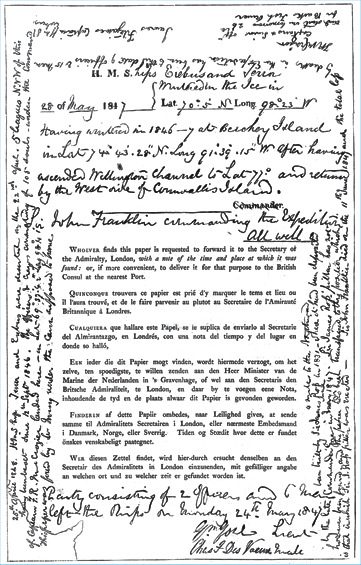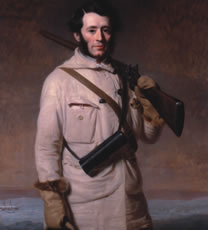MEDIA COVERAGE
Radio 1's Morning Ireland
Dundalk devotes exhibition to Arctic Fox
RTE's Nationwide
Exhibition on Dundalk polar explorer
The Franklin Searches
The Franklin Searches IV: 1857-1859
 McClintock returned home in October 1854 with much on his mind despite having been promoted to the rank of Captain. The Belcher expedition was widely seen to have been the worst Arctic expedition ever embarked upon, and now the Admiralty had indicated that it did not intend to dispatch further searches. Moreover, Francis’ mother had died in January of that year and the return to the family home in Dublin was an emotional one.
McClintock returned home in October 1854 with much on his mind despite having been promoted to the rank of Captain. The Belcher expedition was widely seen to have been the worst Arctic expedition ever embarked upon, and now the Admiralty had indicated that it did not intend to dispatch further searches. Moreover, Francis’ mother had died in January of that year and the return to the family home in Dublin was an emotional one.
The discovery, earlier that year, by John Rae that a group of Inuits had seen a party of 40 white men in the region of the Great Fish River heightened speculation that this could have been the stricken expedition. Worse was to follow with the assertion that 30 bodies had been discovered and that evidence of cannibalism had been found. This news prompted Sir John Franklin’s wife, Lady Jane, to raise another search party and she wrote to McClintock asking him to take charge of the 177 ton Fox. This request was accepted and, having secured leave of absence from the Admiralty, he set about organising the refit of the Fox and assembling a suitable crew.
In the early stages of the expedition, McClintock ensured that the men practiced building snow huts for use in winter or early spring travel whilst officers practiced conducting magnetic observation. Search plans for the expedition combined both the search for Franklin as well as the desire to map uncharted areas of the Arctic.
Initially McClintock’s party succeeded in discovering 120 miles of new landscape. In the course of their search, they met with Inuits who possessed forks and spoons that had belonged to members of the Franklin party. Further exploration of the area revealed an Inuit village in possession of items from the missing expedition. A subsequent search of the area revealed a dismantled cairn, unfortunately nothing was found to reveal the events that had befallen the missing expedition. This was to change with the discovery of a recently constructed cairn made by another sledge party from the Fox. The cairn contained a document (see below) that confirmed two things:
I. that the expedition had successfully survived the first winter in the Arctic but Franklin had himself died on June 11 1847
II. that the ships had become caught in pack ice, drifted and ultimately crushed.
Further searches of the area failed to locate either the Terror or the Erebus. When all three search parties had returned to the Fox the wait for the summer thaw began and with it the return home with the only documentary evidence found on the fate of Franklin. Again McClintock’s all-round skills came to the fore when taking sole charge of the engineroom following the deaths of the two onboard engineers.


